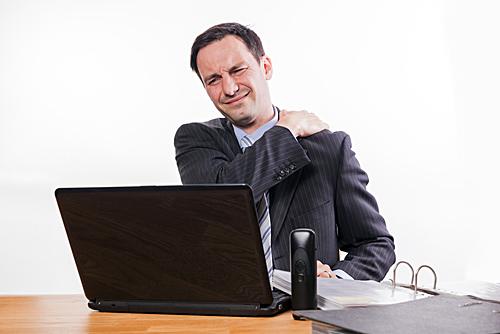You may have thought these were just figurative expressions, but they can be quite literal. In fact, nearly every week, I see patients in my acupuncture practice who have pain conditions caused by nothing other than frustration. Held for long enough, frustration turns to pain.
In my experience, treating stressed New Yorkers with acupuncture, the most common areas of pain caused by frustration are in the neck, shoulders, and upper back (“pain in the neck”) and in the hip and lower back (“pain in the butt”). Pain in neck, shoulders, and upper-back can also cause tension headaches (as in “giving me a headache”).
The reason for this is quite simple: These are the areas that get tense when we physically express frustration. If frustration is expressed, or “embodied,” for long enough, these tense muscles develop painful knots, (aka “trigger points”), which often correspond with acupuncture points and can be stubborn and difficult to get rid of.
Have you ever had a massage and the masseuse exclaims, “Wow! You have so much tension in your back!”? Have you ever felt emotionally rejuvenated after a massage… until the end of your next workday, when your back is all knotted-up again?
Have you ever noticed how loose your muscles get when you go on vacation? Muscle tension is a direct expression of psychological “tension.” Muscle tension (embodied in facial and postural expressions) is how we express our emotions to each other and how we feel our own emotions.
Massages do not take tension away for long. But don’t worry, you do not have to quit your job or have a massage every day to have less tension. Of course, it is inevitable that I will point out that acupuncture is a more profound and lasting way to release embodied emotional tension, but that is not what I want to share today.
I want to underline the fact that what you do after the acupuncture is where real powerful changes can happen. It is all about learning to identify where you feel tension and how to control how much tension you are experiencing.
The Root Cause
To start, we must determine what we are actually feeling. We often say that we are “stressed” or “tense,” but the vagueness of these labels can prevent us from acknowledging the precise emotions we are actually feeling.
For example, “stressed” could mean worried, anxious, and fearful, or it could mean frustrated, overburdened, and short-fused. What are you actually feeling when you acknowledge that you feel “stressed”?
Secondly, we must determine where we are actually expressing and feeling this tension. Each emotion is expressed by a different chain of muscles (also known to acupuncturists as “acupuncture channels”). Frustration and feeling burdened, for example, manifest as tension in the upper back, neck, and buttocks (toughening our back like “armor” and reinforcing our neck, arms, and legs to prepare ourselves for a fight).
Anxiety and fear, on the other hand, are expressed in muscles along the front of the neck, chest, and abdomen (locking the head in position to avoid being noticed by the passing predator, and starting to curl the body toward a crouch, duck, or fetal position, the most inconspicuous and protected postures).
How Emotions Affect Muscles
Happy inspiration and depressed lethargy, are just two examples of the ways in which emotional expression actually changes the activity of our organs in order to accentuate the feeling of that emotion.
Happiness. We express happiness as a smile, a pattern of tension in the facial muscles. Happiness is also expressed by rib muscles, which open the chest, making it easier for us to breathe more fully.
Inspiration. Feeling inspired also involves these chest-opening muscles. It is no wonder, then, that “inspire’ literally means “breath in.”
Depression. On the other hand, depression uses another set of rib muscles that literally depress the chest and make our breathing shallower. There is a very good reason for this: Having less oxygen naturally makes us feel low-energy and reinforces our depressed and lethargic state—just as having more oxygen helps us feel happier and more excited.
Frustration and Fatigue. Too many of us tense our upper back, neck, and shoulders, and slouch forward, making ourselves feel frustrated and fatigued. This bad habit of expressing frustration and fatigue in our posture can become a real “pain in the neck” or “pain in the butt,” or “give us a headache” and not just because it causes pain, but because it makes us feel even more frustrated and fatigued.
First Steps to Pain Relief
Research has proven that it is indeed the case that—where our feelings are concerned—we can “fake it ‘til we make it.” My advice is to do the following and notice how your feelings change:
• Smile.
• Open up your chest.
• Choose to feel happier.
• Sit up straighter.
• Stand tall.
If you want to see more research about the body-mind connection, look up a new wave of psychology research called “embodied cognition,” which studies how our bodies directly affect our minds. Through this research, I hope to one day to map out and prove exactly how acupuncture works—by releasing chronically-held emotional tensions.
Nicholas C. Steadman, L.Ac., practices acupuncture in New York City, specializing in stress-induced pain and disorder. Steadman previously taught at the Pacific College of Oriental Medicine and is now working on a book about embodied emotion. www.GRUV-IN.com
“Neck pain” image courtesy of Shutterstock.com.


Friends Read Free